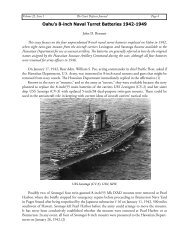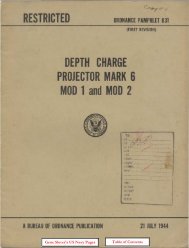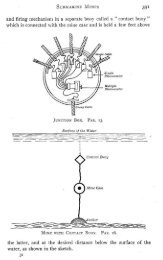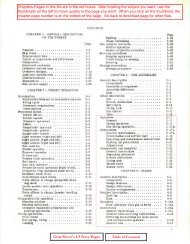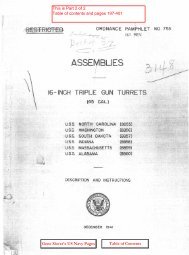...Railway artillery - Personal Page of GENE SLOVER
...Railway artillery - Personal Page of GENE SLOVER
...Railway artillery - Personal Page of GENE SLOVER
Create successful ePaper yourself
Turn your PDF publications into a flip-book with our unique Google optimized e-Paper software.
695<br />
667. The diagram makes no allowance for curv(>s. but it is safe for<br />
"quipment .whose truck centers do not exceed 40 feet. On railway<br />
mounts whose trucks centers exceed this dimension, allowance must<br />
be made for the overhang <strong>of</strong> the mount in rounding curves. It is<br />
safe to figure a maximum curve <strong>of</strong> 17 degrees, 337 feet radius, on the<br />
main lines <strong>of</strong> railroads shown. Hence, the width <strong>of</strong> the mount wilt<br />
be reduced at least as much as the computed <strong>of</strong>f-set on a 17-degree<br />
curve. A full discussion <strong>of</strong> railroad curves will be given later.<br />
668. It was early recognized that to compile a clearance diagram<br />
<strong>of</strong> every railroad system in the country would be an endless and<br />
indeterminate task as well as being worthless when completed. The<br />
futility <strong>of</strong> attempting to establish such an absolute clearance diagram<br />
<strong>of</strong> every road is best illustrated by the following facts: There<br />
are over 250,000 miles <strong>of</strong> railroads in America. Some <strong>of</strong> these roads<br />
are inaccessible to any but the lightest railway equipment and are<br />
.located in the interior mountainous regions. For instance, some<br />
standard gauge railroads are used only by the lumber interests.<br />
Special logging cars and locomotives comprise the rolling stock <strong>of</strong><br />
these roads. Obviously no piece <strong>of</strong> railway a.rtillery could ever be<br />
transported over such tracks. Such roads would therefore be useless<br />
for railway <strong>artillery</strong> shipments and have not been considered.<br />
669. Other railroads, while using standard equipment, touch only<br />
the small central and western interior towns. These roads are generally<br />
branches <strong>of</strong> the larger systems and it is improbable that any<br />
emergency could ever arise for their use. If it did, the branches would<br />
have to be rebuilt. These roads are not considered on the diagram.<br />
670. To compile a maximum clearance diagram <strong>of</strong> all the big railroad<br />
systems <strong>of</strong> the country would result in such limitation <strong>of</strong> dimensions<br />
<strong>of</strong> the railway mount that one could not lise it for the design <strong>of</strong><br />
the heavier caliber guns. The branch lines <strong>of</strong> some <strong>of</strong> these systems<br />
present limitations that sometimes interfere with their. standard equipment,<br />
but the territory covered is so important that lighter rolling<br />
stock is used. Hence it would be unwise to limit the diagram by including.<br />
all branch lines <strong>of</strong> the big systems. Some <strong>of</strong> the branch<br />
lines, however, are <strong>of</strong> vital importance and these have been included.<br />
If it is not possible to reach an important point from one line on<br />
account <strong>of</strong> some limiting feature, it has generally been found possible<br />
to detour to that point.<br />
671. It must not be presumed from this discussion that railway<br />
clearances can be compiled into a fixed outline or diagram. The<br />
more progressive railroad companies are constantly changing their<br />
clearances and improving their curves. So to keep up to date, it is<br />
necessary to keep in touch with the railroad engineers. These<br />
changes should be checked up (>v(>ry six months and the diagrams<br />
changf'd if a1f(>ctf'd.<br />
Digitized by Coogle



